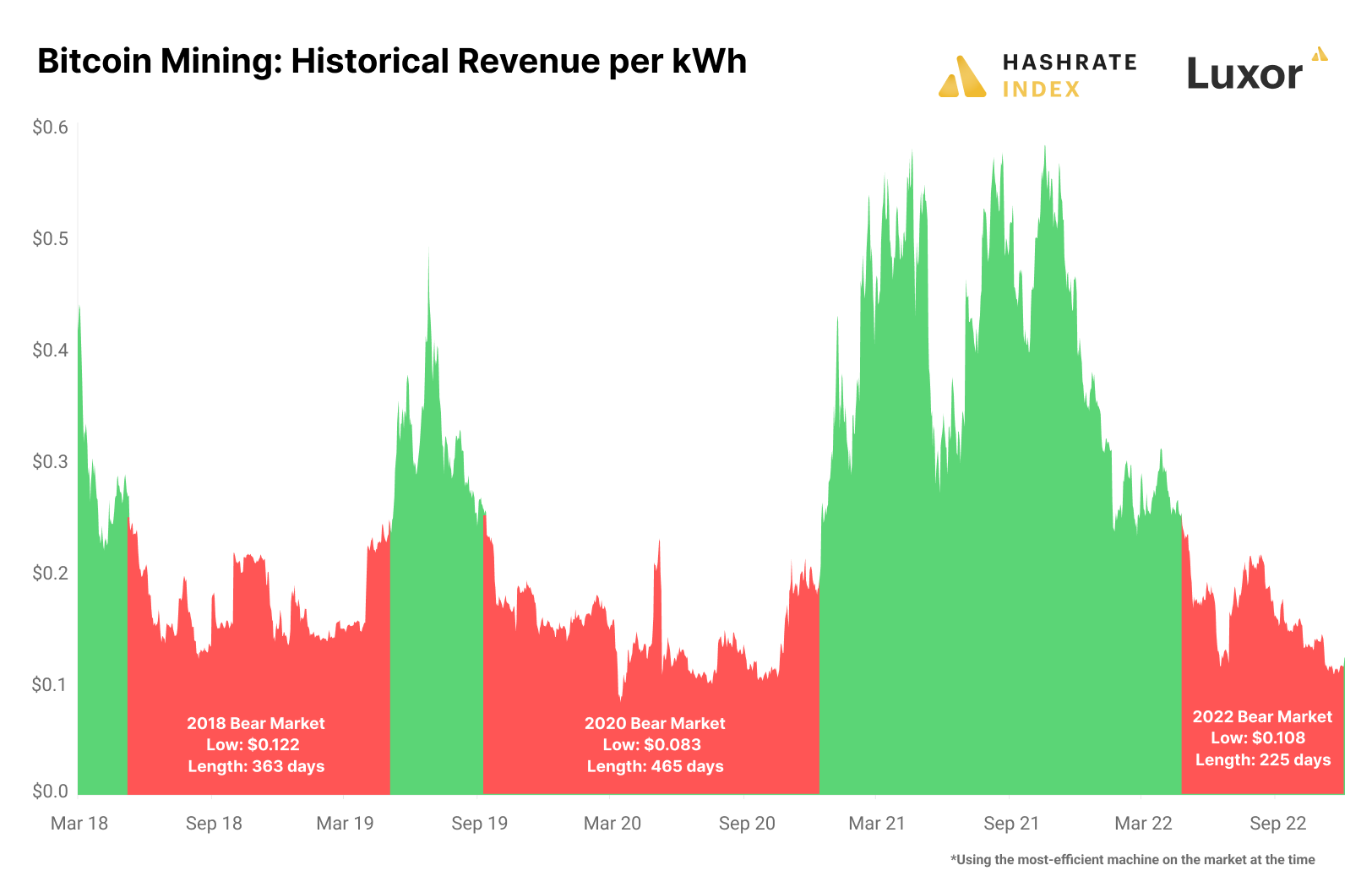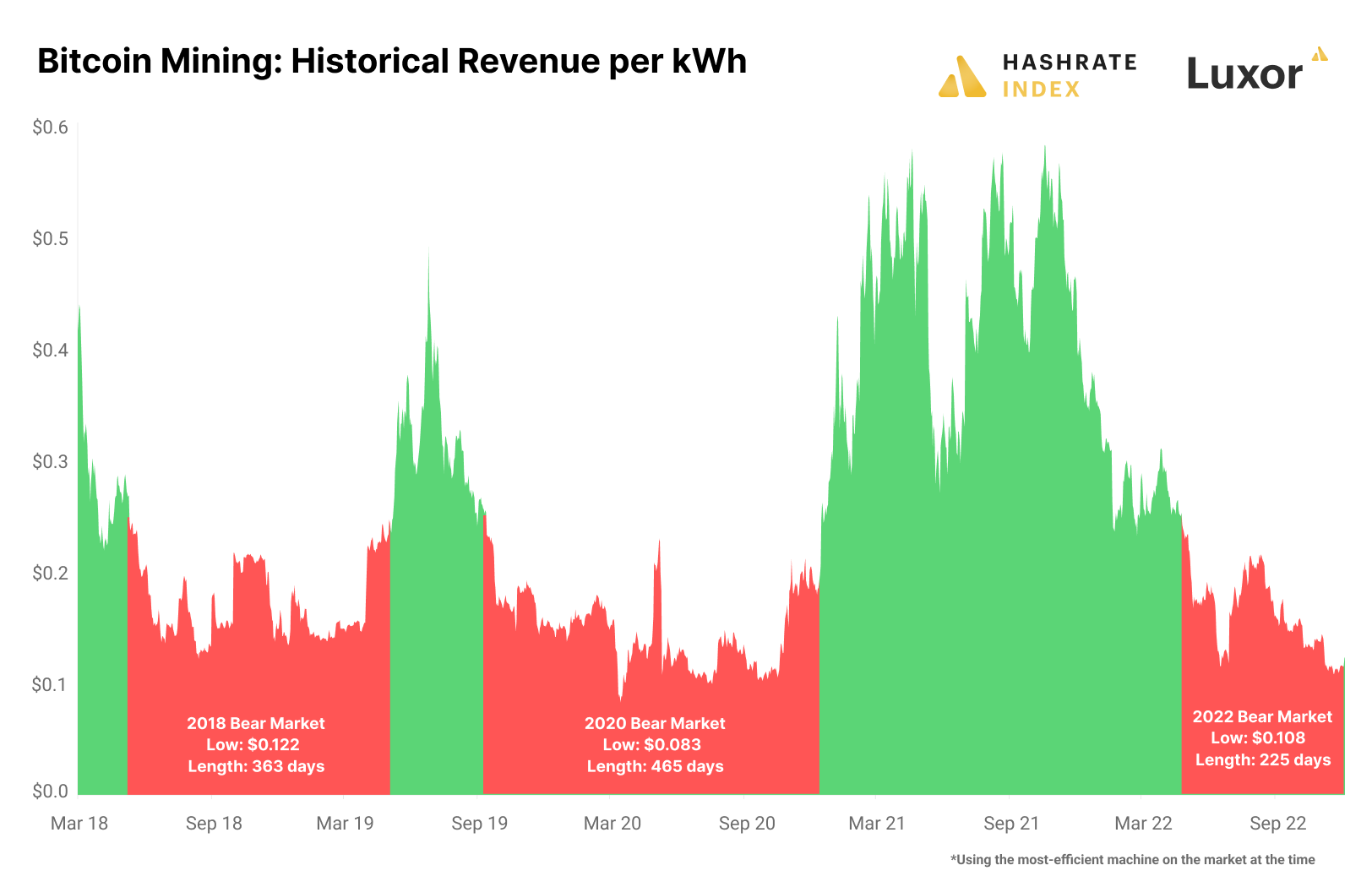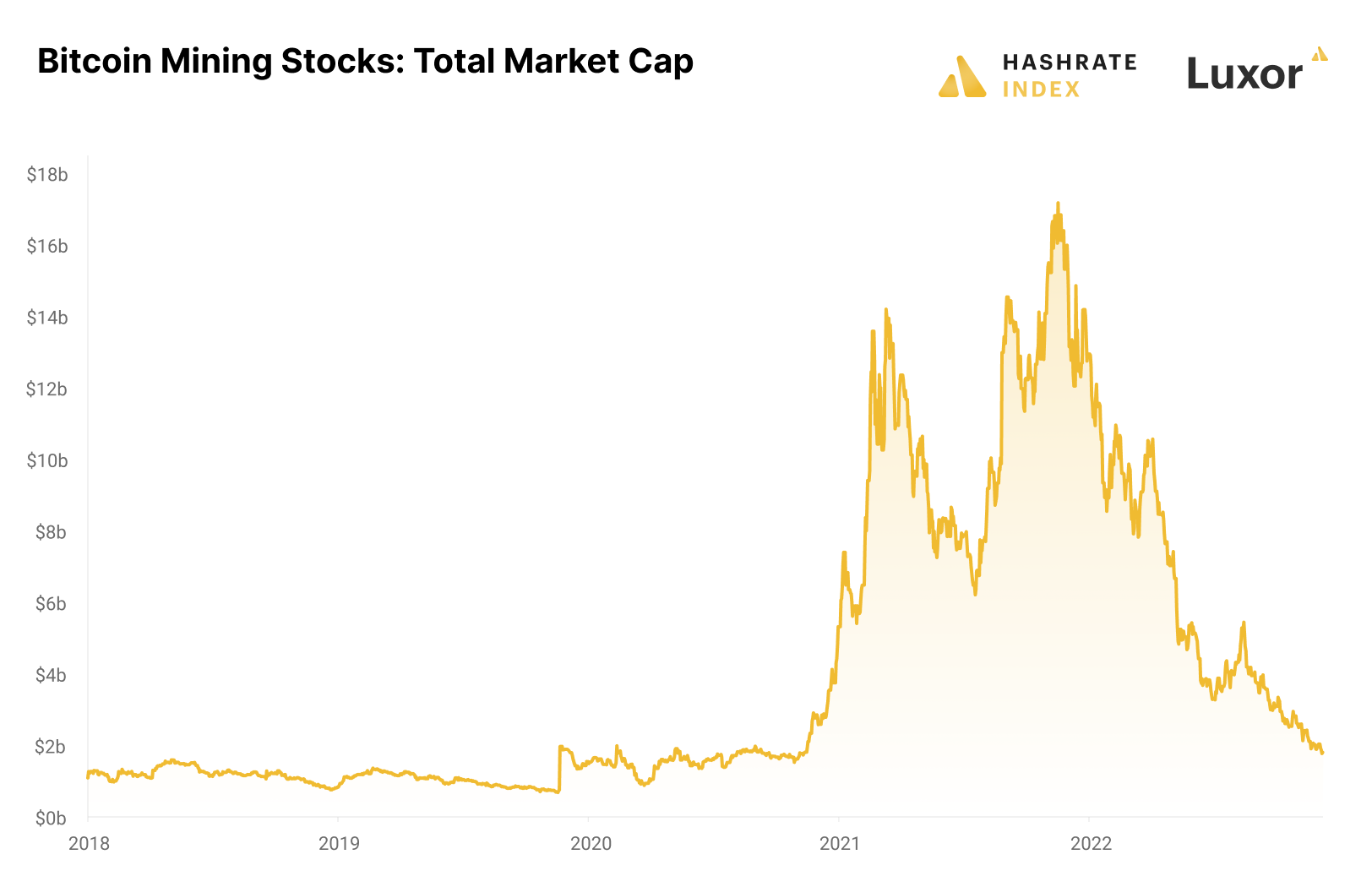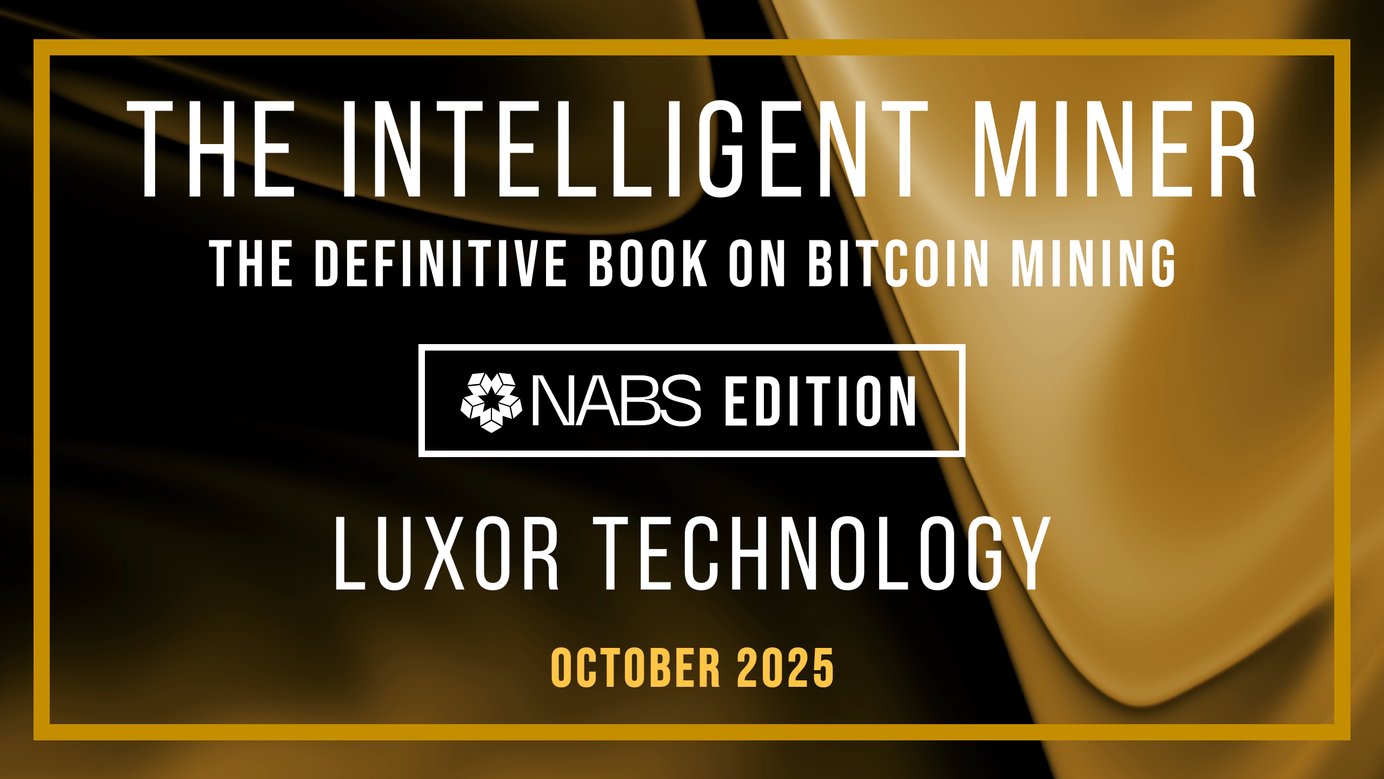
How Does the Current Bitcoin Mining Bear Market Compare to Previous Ones?
Is the current bear market the worst in the history of bitcoin mining? How long could it take before bitcoin mining profitability returns to higher levels? This article attempts to answer those questions by comparing the current bitcoin mining bear market to two previous ones.
The last two years blessed us with an excellent case study on bitcoin mining's exceptionally cyclical nature. At the end of 2020, one of the most profitable periods in bitcoin mining's history began. The fun lasted until early 2022, when a lethal combination of a falling bitcoin price and growing hashrate pushed mining economics down to depressing levels.
Although the current bear market is devastating for those with high operating costs and elevated debt levels, mining economics were significantly worse and stayed depressed for much longer during the previous bear market. We are all praying for the bear market to end soon, but is it realistic? Studying how the economics of bitcoin mining has developed through previous bear cycles could hint at how long the current bear market could last and how bad things could ultimately get.
Previous bear markets have been worse and lasted longer than the current one
Before starting our analysis, we must adequately define a bitcoin mining bear market. The traditional definition of a bear market is a sustained period of falling asset prices. This article focuses on the intrinsic economic state of the bitcoin mining industry, not on asset prices. Therefore, for this analysis, I define a bitcoin mining bear market as a sustained period with depressed profitability levels for bitcoin miners.
How do we then measure the profitability of bitcoin mining? The business model of bitcoin mining is to turn energy into bitcoin. Therefore, the cleanest measure of bitcoin mining profitability is the revenue per kWh. This metric is also known as the break-even price per kWh since it is the maximum a bitcoin miner can afford to pay for electricity if it is to operate with a positive gross margin. My definition of a bitcoin mining bear market is a sustained period with revenue per kWh of less than $0.25, using the most energy-efficient machine on the market.
Let's look at how revenue per kWh has developed over time to identify bear markets. As we see on the chart below, three distinct periods since early 2018 fit into my definition of a bitcoin mining bear market. In this analysis, we will simply call these periods the 2018 bear market, the 2020 bear market, and the 2022 bear market.

The 2018 bear market lasted from May 2018 until May 2019. In this year-long period, the bitcoin price stayed relatively flat simultaneously as the hashrate surged due to capacity expansions initiated during the 2017 bull market coming online. The poor mining economics in 2018 culminated in the revenue per kWh hitting a bottom of $0.122. As I will explain in the last section, this bear market is the most comparable to the current one.
We then briefly enjoyed a mini bull market during the summer of 2019 before another bear market commenced in September 2019. This bear market lasted 463 long days and saw an all-time low revenue per kWh of $0.083 in March 2020 when the bitcoin price plunged to $5k.
In December 2020, the most recent bitcoin mining bull market took over. Although the bull market in 2017 was even more profitable, the one in 2021 lasted longer and saw more capital thrown at the bitcoin mining companies. I will come back to the latter point in the next section.
Bitcoin mining economics stayed elevated until April 2022, when the current bitcoin mining bear market started. It has lasted for 225 days and seen a minimum revenue per kWh of $0.108. Although revenue per kWh is 30% higher now than at the 2020 bottom, profitability levels for most miners should be similar due to significantly higher energy prices now than in 2020.
We see that previous bear markets have been longer and seen worse mining economics than the current one. In the last section of this article, I discuss how long the current bear market could last and how much worse it ultimately could get based on these previous bear cycles.
Bitcoin miners expanded heavily going into 2022 – leading to massive capital destruction
In the previous section, I showed that from a profitability perspective, the current bitcoin mining bear market has not been as bad as the previous ones, as the revenue per kWh was significantly lower in 2020. Still, when it comes to capital destruction, no other bear market even comes close to the current one.
During previous bear markets, most bitcoin mining companies were privately funded, limiting the amount of outside capital in the industry. At that time, most bitcoin miners organically financed their operations using cash flows from operations.
The private nature of the industry changed abruptly in late 2020 when an army of bitcoin miners started going public to take advantage of some of the hottest stock market conditions in modern history. Allured by the expectations of outperforming bitcoin during the bull market, investors threw money at these companies in 2021, leading the industry's market cap to surge from $2 billion in November 2020 to $17 billion one year later.

As market conditions worsened, the industry's market cap fell by 90% and is back to its late 2020 level of $2 billion. Most of these companies have raised enormous amounts of equity during this period and significantly diluted shareholders. Therefore, most investors who bought these stocks even in late 2020, before the bull market, are significantly underwater with their investments.
A handful of public bitcoin miners are now close to bankruptcy as the depressed mining economics render them unable to generate sufficient operating cash flow to service debt. We will likely see a few bankruptcies and restructurings before this bear market is over.
Unlike previous bitcoin mining bear markets, the struggles of some of the industry's most prominent players are now visible to the entire world, leading to an increased public interest in this bear market compared to previous ones.
How could the current bear market unfold from here?
The 2018 bear market is comparable to the current one since it happened around the same stage in the halving cycle after a massive bull market. Like now, miners of 2018 watched in horror as the bitcoin price fell simultaneously with the hashrate growing. The 2018 bear market lasted 363 days until a mini bull market took over in the summer of 2019.
The current bitcoin mining bear market has only lasted for 225 days. Judging by the length of the 2018 bear market, we might have to wait until April 2023 before mining economics substantially improve. Still, the unpleasant caveat is that the mini bull market following the 2018 bear market only lasted four months before turning into the 465-day-long 2020 bear market.
If the previous cycle repeats itself, we could see a prolonged bear market until the next halving in 2024, only interrupted by one or two mini bull markets lasting a few months. Current hashrate supply dynamics further strengthen this hypothesis. A substantial mining capacity is waiting to come online, and the hashrate will likely not stop growing until well into 2023. This hashrate addition will keep putting downward pressure on mining economics for the foreseeable future.
I also doubt that the bitcoin price will go on a new full-scale bull run before at least one to two years have passed. Both retail and institutional investors who got in during the previous bull run have been wrecked, and it takes time before outsiders are ready to invest in the sector again. In addition, the crypto industry's reputation has gotten severely harmed by the FTX scandal, which will further prevent new investors from coming in. Due to these factors, it will take some time before bitcoin is ready for another bull run.
I'm confident better times will come for the bitcoin mining industry, but we will have to wait patiently for conditions to improve.
Thanks to Steve Barbour for his insights.
Hashrate Index Newsletter
Join the newsletter to receive the latest updates in your inbox.








